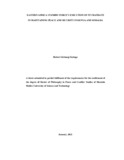| dc.description.abstract | The nature and numbers of intrastate conflicts in the early nineteen nineties
challenged regional security; thereby requiring a collective regional response. This
explains the formation of a number of regional security mechanisms such as East
African Standby Force (EASF) with a mandate to maintain peace and security in the
Eastern Africa region. Despite over a decade of its existence, EASF efforts to tackle
the seemingly intractable peace and security dilemmas in the region and especially in
Kenya and Somalia have remained elusive and insignificant, making it more of a
bystander. This study sought to address this gap. The general objective of this study
was to assess Eastern Africa Standby Force’s execution of its mandate in maintaining
peace and security in Kenya and Somalia. More specifically, the study examined the
structure and nature of Eastern Africa Standby Force; assessed Eastern Africa
Standby Force’s efforts in maintaining peace and security in Kenya and Somalia
and; examined challenges and opportunities arising from Eastern Africa Standby
Force’s execution of its mandate in maintaining peace and security in Kenya and
Somalia. The study adopted a conceptual framework underpinned by three theories;
the Regional Security Complex theory, the Neofunctionalism theory and the Power
theory, all emanating from the Realism school of thought.The study used a
descriptive survey research design. The study was conducted in Kenya and
Somalia.The study utilized simple random sampling strategy to determine the
settings and the participants .A sample size of 385 officials was achieved from the
total population using the Mora and Kloet (2010) formula. The sample size was
distributed evenly across the study areas. Questionnaires, interview guides, and
Focused Group Discussions (FGD) were used to collect primary data whereas
secondary data was gathered from journals and reports. Quantitative data was
analyzed by SPSS version 24 while qualitative data was analyzed through coding,
verbatim and thematic organization. As for the structure and nature of the EASF, the
study found out that EASF has an adequate operational structure with 61% of the
respondents agreeing that EASF had adequate mission support structure to be able to
execute its mandate in Kenya and Somalia. On nature, the study found out that the
EASF does not operate in vacuum and so its operations are shaped by regional
governments, 73% of the respondents avouched that regional governments played a
significant role in maintaining peace and security. As for EASF efforts to enhance its
capability to be able to maintain peace and security, the study found out that EASF
has put in place a number of initiatives. Thus, the study found out that, 67% of the
respondents acknowledged that regional organizations contributed significantly to
EASF efforts to maintain peace and security in Kenya and Somalia.On challenges
and opportunities, the study found out that EASF effectiveness is hampered by dearth
of political cohesion, with 89 % of the respondents agreeing that lack of political
cohesion has a high impact on the performance of EASF in maintaining peace and
security in Kenya and Somalia.Notwithstanding the challenges, the study also found
out that there were opportunities available to EASF in its maintenance of peace and
security in Kenya and Somalia, to include establishment of maritime planning cell in
its structure. The Study concludes that, despite efforts employed by EASF to promote
Peace and Security in Kenya and Somalia, there are prevalent challenges that
continue to undermine and stymie EASF’s effectiveness. This, therefore, calls for
more political cohesion among its member states, renewed commitment of member
states to pledge forces, contribute finances, provide logistic support while
harmonizing its training and doctrines so as to create an effective EASF. | en_US |

